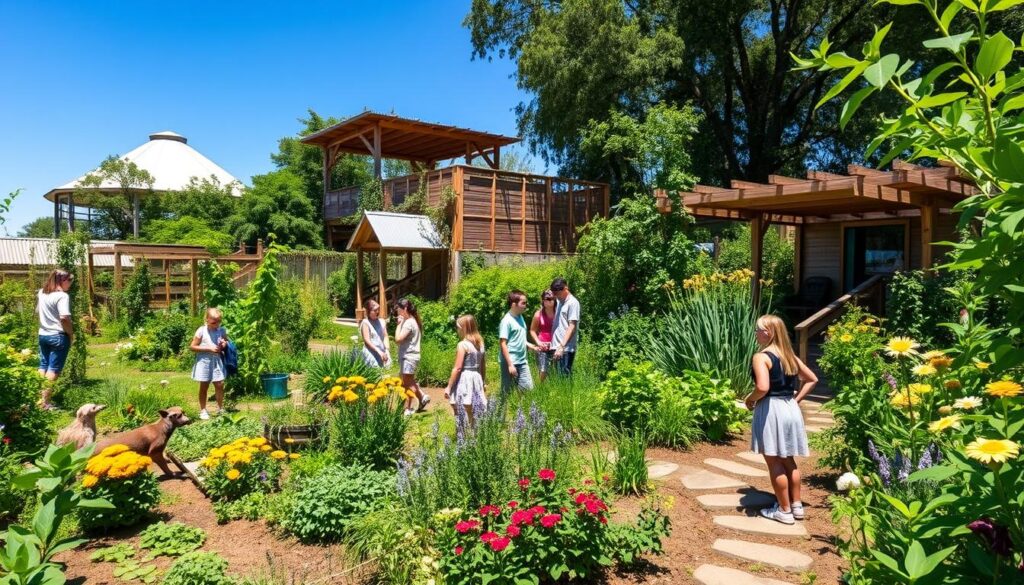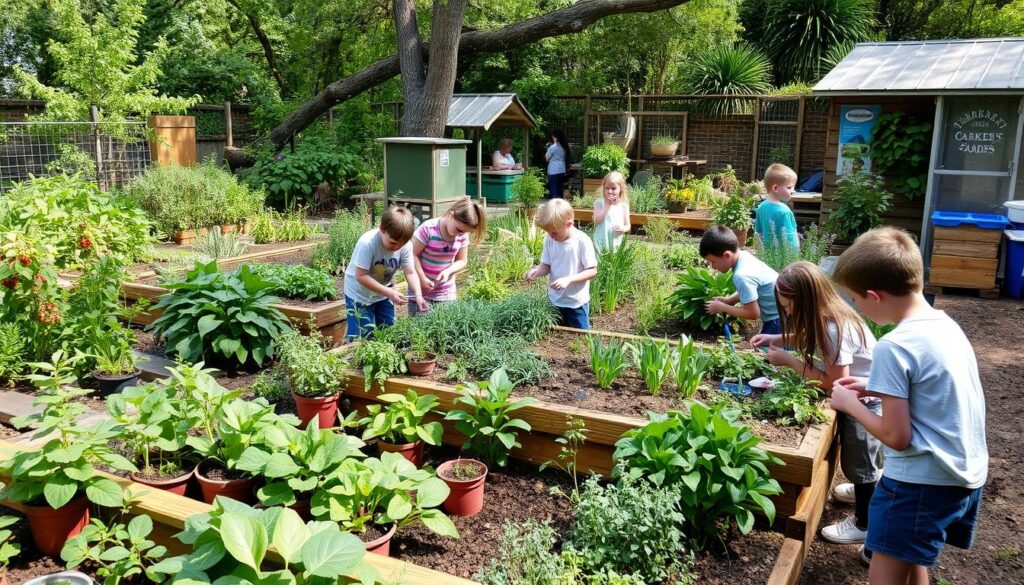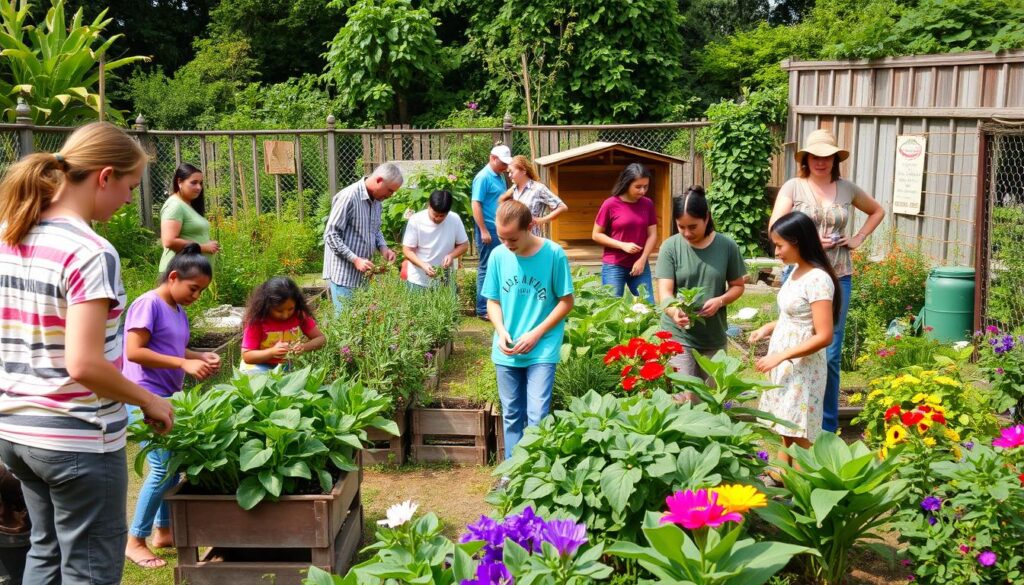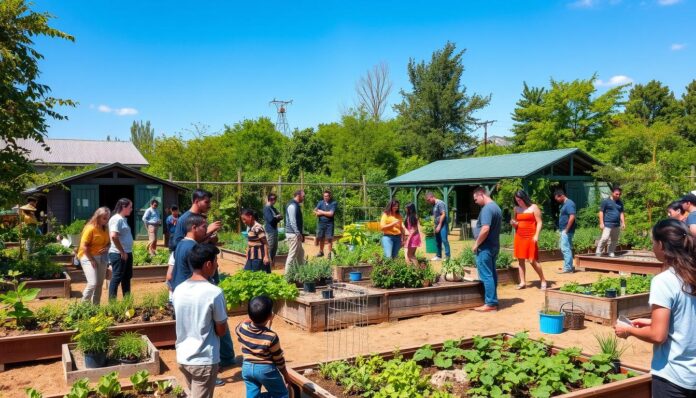How can permaculture education help students connect with nature? It also teaches them about sustainable farming. By making learning hands-on, permaculture education boosts student interest and motivation. This leads to a greener future.
Permaculture education lets students explore nature, think critically, and care for the environment. More universities are adding permaculture to their courses. This shows its importance in teaching for a sustainable world. By focusing on engaging students in permaculture, we can inspire a greener generation.
Key Takeaways
- Permaculture education can increase student engagement and motivation by providing hands-on learning experiences
- Permaculture student engagement is critical for fostering a deeper connection between students and the natural world
- Permaculture education can promote sustainable agriculture practices and environmental stewardship
- Universities are increasingly integrating permaculture into sustainability curricula
- Permaculture education can lead to improved skills in real-world applications and ethical community engagement
- Permaculture student engagement can be enhanced through educational partnerships between permaculture practitioners and academic institutions
Understanding the Importance of Student Engagement
Student engagement is key in permaculture education. It helps students understand and apply what they learn in real life. Through hands-on learning and experiential learning, they get practical experience and important skills. They also learn to care for the environment by using eco-friendly practices.
Engagement in permaculture education has many benefits. It creates a community where students can share and learn from each other. This builds a sense of belonging and motivation. It also helps them see why sustainability and caring for the environment are crucial.
Here are some ways to boost student engagement in permaculture education:
- Offer chances for hands-on learning and experiential learning
- Make the curriculum include eco-friendly practices
- Use group projects and activities to build a community of practice
Key Principles of Permaculture Education
Permaculture education focuses on sustainability, caring for the environment, and fairness. It teaches students about the connection between people and nature. This way, they learn to take care of the planet and their communities.
Some key principles of permaculture education include:
- Applying permaculture ethics to promote sustainability and environmental stewardship
- Integrating systems thinking to understand the interconnectedness of human and natural systems
- Fostering diversity in learning to cater to different learning styles and abilities
By learning these principles, students get a deep understanding of caring for the earth. They are ready to help their communities in a positive way. 
Interactive Learning Techniques
Interactive learning is key in permaculture education. It lets students learn by doing and seeing things in action. This way, they gain practical skills and apply what they learn in real life.
Hands-on activities like workshops and field trips make learning fun and engaging. They help students understand ecological principles better. Plus, they encourage people to work together for a common goal.
Here are some examples of interactive learning techniques:
- Hands-on workshops and activities, such as composting and plant propagation
- Field trips to local farms and urban permaculture projects
- Virtual garden tours and online forums for discussion and knowledge sharing
These methods improve the learning experience. They also help students feel part of a community. This feeling is crucial for building a strong, sustainable food system.
Technology in Permaculture Education
Permaculture education is changing with technology. This makes learning more fun and helps us care for the environment. Students get to use lots of resources, which helps them learn about sustainable farming.
Technology helps permaculture education reach more people. It makes students more interested and eager to learn.
Here are some ways technology is used in permaculture education:
- Apps for garden planning let students design and manage their own gardens.
- Online resources and forums connect students with experts and other practitioners.
- Social media helps students share their experiences and learn from others.
Technology makes permaculture education better and more accessible. It helps teach sustainable farming and caring for the environment. As technology keeps improving, we’ll see even more ways it helps permaculture education. This will lead to a more sustainable future.
Designing Engaging Curriculum
Permaculture education should grab students’ attention and help them learn deeply. It can do this by using project-based learning and linking different subjects together. This approach boosts student interest and motivation. It also teaches them about caring for the environment. Permaculture education should focus on learning by doing and experiencing things firsthand.
Some key elements of an engaging permaculture curriculum include:
- Incorporating project-based learning to promote practical applications of permaculture principles
- Creating interdisciplinary connections to foster a deeper understanding of the relationships between permaculture and other fields
- Engaging local experts and practitioners to provide students with real-world examples and insights
By adding these elements, permaculture education becomes more fun and effective. Students become more motivated and understand permaculture better. Experiential learning methods, like hands-on activities and field trips, also improve students’ knowledge of the environment and science.

Developing Critical Thinking Skills
Learning about environmental stewardship and sustainable agriculture is key in permaculture education. It’s important for students to think critically about these topics. This helps them apply what they learn in real life.
Students learn by solving problems and discussing in groups. This way, they understand eco-friendly practices better. They see how these practices help the environment.
Here are some ways to improve critical thinking skills:
- Encourage students to keep reflective journals. This helps them think deeply about what they learn.
- Start group discussions. This encourages students to share ideas and work together.
- Give them chances to solve real-world problems. For example, they can design and start sustainable agriculture projects.
These methods help students grasp the complex links between humans and nature. They learn to tackle environmental issues of today. Permaculture education prepares students to be leaders in sustainability.
By using these strategies, permaculture education can create a new generation of leaders. These leaders will be ready to face environmental challenges. They will also promote a culture of sustainability and care for the environment.
Community Involvement and Partnerships
Community involvement is key in permaculture education. It helps students feel responsible and connect with their community. By working with local groups and hosting events, permaculture education promotes environmental stewardship and sustainable agriculture. This not only helps the community but also gives students practical experience.
Some ways to get involved include:
- Working with local food banks to give fresh food to those in need
- Hosting workshops and events to teach about sustainable farming and caring for the environment
- Partnering with local businesses to support sustainable practices and the local economy
About 2,280 undergraduate students are at St. Lawrence University. Hendrix College’s community garden lets all students get garden provisions without effort. Volunteers get more. This shows how important community involvement is in permaculture education.

By adding community involvement and partnerships to permaculture education, we support sustainable agriculture and environmental stewardship. Students gain valuable skills and experiences for real-world use.
| University | Permaculture Program | Community Involvement |
|---|---|---|
| St. Lawrence University | Permaculture Design Certificate (PDC) | Collaboration with local food banks |
| Hendrix College | Local community garden model | Volunteer opportunities for students |
Utilizing Multi-Sensory Learning
Multi-sensory learning is key in permaculture education. It lets students learn in many ways. By using nature, students can do hands-on learning like planting gardens. This makes them more interested and active in learning.
This method is also called experiential learning. Students learn by doing, not just reading or listening.
Some good things about multi-sensory learning are:
- Students get more involved and excited about learning.
- They remember things better.
- They learn to think critically and solve problems.
Also, eco-friendly practices can be part of the learning. This includes reducing waste and using renewable energy. Teaching about sustainability helps students value nature more and think about the environment.

Using multi-sensory learning makes permaculture education more fun and effective. It also helps students adopt eco-friendly practices and care more about the environment.
| Learning Approach | Benefits |
|---|---|
| Hands-on Learning | Increased student engagement and motivation |
| Experiential Learning | Improved retention of information |
| Eco-friendly Practices | Development of critical thinking and problem-solving skills |
Facilitating Student-Led Initiatives
Permaculture education puts a big focus on student-led projects. It helps students learn about sustainable farming and caring for the environment. The Edible Schoolyard Project is a great example. Students learn by working in gardens and kitchen classrooms, focusing on food security and justice.
Student projects can be many things, like starting gardens or joining environmental groups. These efforts not only help the planet but also teach students to lead. For example, the Organic Garden Club at Whitman College stopped a plan to destroy their garden. This shows how students can make a difference.
Some examples of student-led initiatives include:
- Garden revivals, which create community engagement and emphasize the importance of outdoor education
- Organic garden clubs, which promote sustainable agriculture and provide students with hands-on experience
- Environmental advocacy groups, which raise awareness about environmental issues and promote social responsibility
By supporting student projects, permaculture education helps shift towards a greener future. It’s key to keep focusing on these efforts. This way, students can become leaders in making our world more sustainable.
| Initiative | Location | Impact |
|---|---|---|
| Garden Revival | Saint Mary’s College High School | Created community engagement and emphasized outdoor education |
| Organic Garden Club | Whitman College | Successfully opposed a plan to pave over their garden, demonstrating student advocacy |
| Environmental Advocacy Group | Various locations | Raised awareness about environmental issues and promoted social responsibility |
Measuring Student Engagement
It’s key to check how students are doing in permaculture classes. This lets teachers know if their methods are working. Hands-on learning and experiential learning are big parts of permaculture teaching. By looking at how students are doing, teachers can get better at teaching.
One way to see if students are engaged is by getting them involved in the community. This makes students feel like they own the project. It also helps them learn by doing, not just listening or reading. Here’s why community projects are good for learning:
| Benefits | Description |
|---|---|
| Enhanced student engagement | Community involvement makes students feel responsible |
| Experiential learning | Projects teach students by doing, not just hearing |
| Hands-on learning | Students learn by doing, not just reading or listening |
By checking how students are doing and using community involvement, experiential learning, and hands-on learning, teachers can make their classes better.
Addressing Diverse Learning Styles
Teaching permaculture needs to reach all kinds of learners. This ensures everyone can learn about eco-friendly practices and environmental stewardship. By adapting teaching methods, students can better understand sustainable agriculture.
There are mainly three types of learners: those who learn by hearing, seeing, or doing. Teachers can use many ways to teach, like hands-on activities, pictures, and group talks. For instance, a study in the Eurasia Journal showed that using tech in teaching really helps students do well.
Here are some ways to teach different learners:
- Use pictures and videos to help learners see things
- Give hands-on tasks like gardening to engage learners who like to do
- Have group talks and discussions to help those who learn by listening
By using these methods, teachers can make learning more fun and effective. This helps students learn about eco-friendly practices and environmental stewardship better.
| Learning Style | Teaching Strategies |
|---|---|
| Visual | Diagrams, videos, visual aids |
| Kinaesthetic | Hands-on activities, gardening, composting |
| Auditory | Interactive discussions, group work, audio recordings |
The Role of Mentorship in Engagement
Mentorship is key in permaculture education. It gives students the guidance and support they need. Hands-on and experiential learning are crucial for a deep understanding of permaculture. Mentorship helps students stay engaged and motivated.
Research shows mentorship is vital in permaculture education. The Art of Mentoring course, starting in 2009, has a long history in nature mentorship. Participants often say it was a life-changing experience, showing its impact on personal growth and engagement.
Benefits of Mentorship
The benefits of mentorship in permaculture education include:
- Increased student engagement and motivation
- Improved understanding of permaculture principles and practices
- Development of hands-on skills and experiential learning
Creating alumni networks helps permaculture education offer ongoing support. This support continues even after students finish their studies. It builds a community and encourages lifelong learning.
Promoting Sustainability Beyond Permaculture
Today, taking care of our environment is more important than ever. We need to spread the word about sustainability beyond just permaculture. By teaching others and practicing green living, we can all make a big difference. This includes supporting farming that’s good for the planet and using eco-friendly ways in our daily lives.
Here are some ways to help the planet:
- Start using eco-friendly practices every day
- Buy food that’s grown locally to support green farming
- Get involved in your community to teach others about caring for the earth
It’s also important to share knowledge with each other. By teaching and learning from one another, we can build a better future. We can do this through community events, workshops, and educational programs. These should focus on taking care of our environment and farming in a way that’s good for the planet.
Together, we can make the world a greener place. We must keep pushing for sustainability and encourage everyone to join in. This is how we can create a better future for all of us.
| Strategy | Benefits |
|---|---|
| Implementing eco-friendly practices | Less harm to the environment, saves money |
| Supporting sustainable agriculture | Food that’s grown close to home, better food security |
| Encouraging environmental advocacy | More people getting involved, learning together |
Creating an Inspiring Learning Environment
Permaculture education focuses on creating a learning space that inspires students. It aims to make classrooms welcoming and engaging. This approach encourages students to get involved and learn through doing.
Studies show that a safe and supportive learning environment helps students grow. Classrooms should meet the needs of all learners, whether they prefer to see, hear, or do things. Using different teaching methods, like quizzes, field trips, and group talks, can help. For example, quizzes can teach about personal impact on the environment, while field trips offer real-world learning.
Learning within the community is key in permaculture education. It helps students develop skills and leadership. By working with local groups and doing outdoor activities, students learn about sustainability and food security. The permaculture way, focusing on caring for Earth, people, and fairness, applies to education too.
Here are some ways to make a learning environment inspiring:
- Design classrooms that fit all learning styles
- Use outdoor spaces for hands-on learning and community work
- Make classrooms flexible to encourage student participation
By using these methods, permaculture education can give students a rich and motivating learning experience. This prepares them for a sustainable future.
Looking Ahead: Future Trends in Education
As permaculture education grows, we must look to the future. We need to understand the trends that will shape this field. Innovations in learning, global networks, and tackling climate change will be key.
Innovations in Permaculture Learning
Educators are finding new ways to teach permaculture. They’re using virtual reality, augmented reality, gamification, and interactive simulations. These methods make learning about sustainable agriculture and environmental stewardship fun and hands-on.
The Role of Global Networks
Permaculture education is becoming more global. This means educators, practitioners, and learners from all over will connect more. Virtual and in-person communities will share ideas, best practices, and resources. This will empower the next generation of environmental stewards.
Preparing for Climate Change Challenges
Permaculture education will help students face climate change challenges. Curricula will include lessons on building resilient food systems and reducing environmental impact. Students will learn sustainable living practices for a changing climate.

